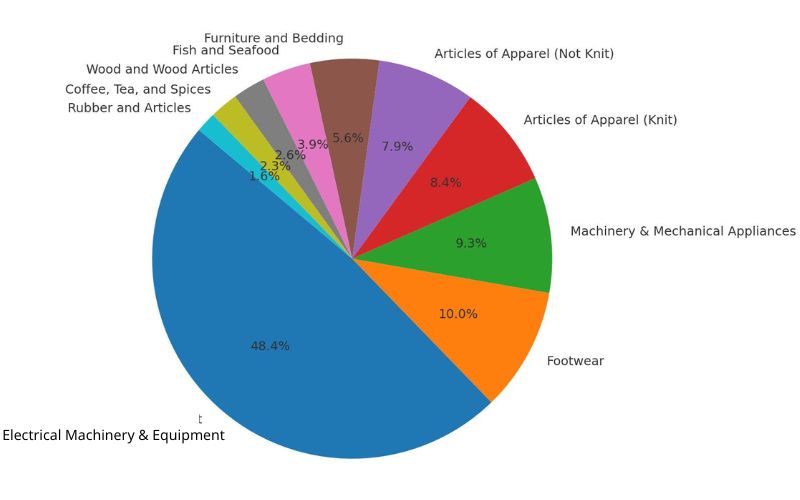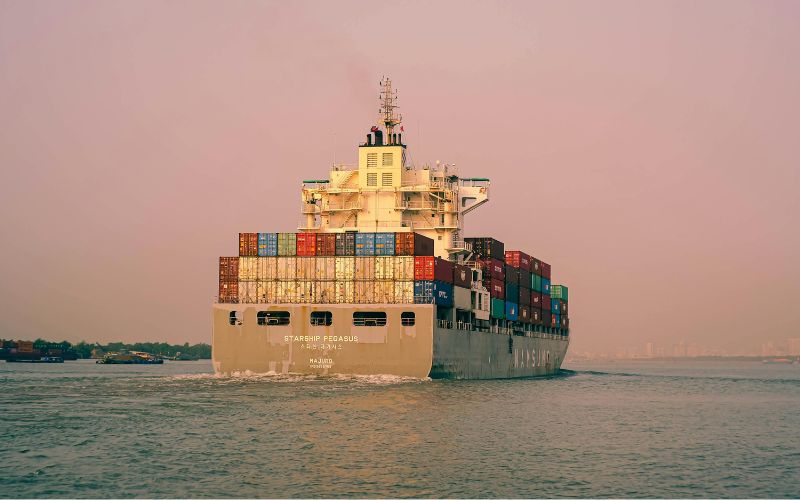Vietnam offers an extensive range of products at comparatively affordable prices. That’s why more international customers are now starting to consider it a fine alternative to purchasing from China. And here’s something that might surprise you — in the past year alone, Vietnam exported over $405 billion worth of goods. Sounds like a lot, right?
But the greatest question of all is, how to source goods from Vietnam efficiently? In this article, we will take you through some useful tips to guide you on how to find good suppliers. We will also point out a few things to keep an eye out for so that you can clear your goods through customs without issues.
Vietnam Sourcing 101: What Every Buyer Must Know
If you’re new to buying from Vietnam, there are a few things that might surprise you. Nothing too complicated, just some real stuff we’ve learned along the way:
1. Supplier Landscape: Mostly SMEs, Still Manual
In Vietnam, almost 98% of all businesses are SME — all but a tiny fraction of small, local, typically family-run factories. They’re basically the backbone of the local supply chain.
In addition, most of them remain traditionally run. Planning production, pricing, and even monitoring money — they’re typically done on intuition, handwritten notes, or basic Excel spreadsheets.

2. Communication Habits: Zalo First and Foremost
Trying to talk to Vietnamese suppliers? They will likely invite you to get hooked up on Zalo — Vietnam’s version of WhatsApp, but used more here. Seriously, they do everything on Zalo — calls, texts, photos, quotes — all of it.
Email is just for things like sending contracts or confirming orders. Regarding CRMs, they have none of them.
3. Business Culture: Trust First, Process Later
The next thing about doing business with Vietnam is that people care more about whether they can trust you than about having a perfect contract. Contracts are still needed (when things go wrong), but basically what makes partnerships work here is socializing in tandem — eating, chatting, working with one another.
4. Export Maturity: Not All Industries Are on the Same Page
As we mentioned at the beginning, Vietnam exported a huge amount of goods last year. But the key categories go mostly to shoes, clothing, and electronics. While these …, many sectors remain relying on manual production, inconsistent quality control, or lack standardized certifications.

How to Source Goods from Vietnam: A Step-by-Step Guide
Once you’ve got the hang of how things work here and what to expect from local suppliers, you can start with these 7 easy steps to bring goods in from Vietnam:
Step 1: Be Clear About What You Really Want
Vietnamese suppliers usually expect buyers to give very clear and detailed product specs from the beginning. They don’t typically ask a ton of follow-up questions. So, it’s important that you take a moment to nail down what you’re after.
Don’t just say you want to import “chairs” or “T-shirts.” That’s way too vague. Think about the stuff:
- What size?
- What materials?
- What color, texture, and finish?
- Does it need to meet any standards or hold up under certain conditions?
- Do you need custom packaging? Special labeling? Certifications like CE or FDA?
Let’s say you want to source wooden chairs. Ask yourself — are these dining chairs, or something else? What wood do you want — oak, rubberwood, acacia? Do they need to be pre-assembled or flat-packed? Are there sustainability requirements?
The clearer you are from the start, the fewer headaches later on how to source goods from Vietnam.
Step 2: Start Browsing (and Narrowing Down) Suppliers
Now that you know what you want, it’s high time to find a good supplier. Typically, there are two ways to find suppliers for sourcing Vietnam goods:
- Internet search: Keywords to look for are “Vietnam [product] manufacturer” or “Vietnam [product] supplier”. You may be referred to B2B sites, company websites, or business directories. The more detail you include in your search (e.g. material, certification, MOQ), the more relevant and qualified the results will be.
- Trade fairs: Another way is to visit expos. The country often holds industry-specific trade fairs, typically from 5 to 10 major events per year across key sectors. You can search for events like Agri Vietnam (for food/agriculture), HCMC Export (multi-categories), or VIFA EXPO (furniture and home decor).
Once you have a list of Vietnam manufacturer names, you can whittle them down by matching them against what you have defined in Step 1. From there, select 3 to 5 that appear to be going to be a good fit and message them to find out a quote.
Inside a metalworking factory in Vietnam.
Step 3: Review the Quotes
At this stage, you hopefully have some quotations from the Vietnamese suppliers you contacted. Oftentimes, a quotation document or email should have the basics for easy comparison.
Look for these key details:
- Product specifications (material, dimensions, color, packaging)
- Unit price and total cost
- Minimum order quantity (MOQ)
- Production lead time
- Payment terms (deposit, balance, methods)
- Incoterms (e.g. FOB, EXW, CIF)
- Shipping method and cost (if included)
Vietnamese suppliers are not always good at breaking down the full cost structure clearly. Thus. you need to consolidate the information yourself to come up with the final landed cost. From there, pick one or two suppliers with the best value and reliable communication for further vetting.
Step 4: Ask for Samples and Inspect the Quality Yourself
In Vietnam, free samples may not always be given by all suppliers, especially if you are just transacting with them for the first time. Some of them might insist that you pay for the sample or at least for shipping it. That is highly normal and many buyers just pay for it to speed things up.
When you receive the sample, don’t just look at the product. Ask yourself:
- Is this what I ordered?
- Is there quality to my standards?
- Are there defects which will cause problems later?
A sample is one of the best ways to test how serious a supplier is. If they deliver on this stage well, it’s a good sign that they might be a good partner for a big order.
Step 5: Negotiate Terms and Get It All in Writing
Once you’re happy with the supplier, it’s time to lock down the deal. Things you’ll want to finalize on:
- Final price
- Production timeline and delivery date
- Deposit amount and when to pay it
- Shipping terms (FOB, EXW, CIF, etc.)
- Payment method (T/T, L/C, etc.)
Also, talk about what happens if things go wrong. What if the goods arrive damaged or late? Will they fix it, replace it, or refund you?
Again, manufacturers from Vietnam are quite informal when it comes to documentation. They will not automatically issue detailed contracts, and you should request everything in writing. Ideally, get a signed proforma invoice or sales agreement that outlines all key terms to avoid misunderstandings or disputes later.
Step 6: Watch Over Production
Mistakes can happen, and in Vietnam, suppliers may not always update you unless you ask. The best way to stay in the loop? Use Zalo. Most suppliers will be happy to send over photos, short videos, or quick updates as production moves along.
If you want extra peace of mind, you can also hire a local quality control (QC) team or a third-party inspection company to check the goods before they’re shipped.
Step 7: Set up the Shipping & Customs
You now have to figure out how you actually ship your items from Vietnam to your warehouse (wherever they’re going). Start by figuring out who is doing what. Shipping terms like FOB, CIF, or EXW tell you whether the supplier or you pay for the different parts of the trip, including the cost.
Three major shipping options from Vietnam:
| Shipping method | Key features | Delivery time |
| Air freight | Fast but expensive.
Best for small, high-value items like electronics or urgent orders. |
2–7 days, limited to lightweight cargo (~4-15kg) |
| Sea freight | Economical for bulk goods like furniture or apparel.
Much slower than air. |
~20–40 days (to USA and EU)
~7–21 days (to Japan and Korea) |
| Land transport | Low cost, suitable for nearby countries like China, Cambodia, Laos.
Cost varies by distance and weight. |
As fast as 1 day |
Also double-check your documents. Make sure all (invoiced, packing list, certificate of origin, etc.) is accurate. If your importing country requires certificates, make them ready as well.

Key Considerations For Importing Goods from Vietnam
So that’s how you can import goods from Vietnamese suppliers. Now, here are some helpful tips to make things even easier:
1. MOQ and Lead Times Differ A Lot
Minimum order quantities (MOQs) and lead times in Vietnam literally depend on what you’re purchasing and who you’re sourcing from. There’s no one-size-fits-all. Some factories are accommodating; others are not.
Here’s a rough estimate based on typical product types:
| # | Product Category | MOQ | Estimated Lead Time | Estimated FOB Price Range |
|---|---|---|---|---|
| 1 | Activewear (e.g., sublimated sports jerseys) | 1,000–3,000 pcs | 10–12 weeks | $5.5–7.0 per garment* |
| 2 | Workwear | 1,000+ pcs | 6–12 weeks | approx. $6–12 per piece* |
| 3 | Sneakers | 500–10,000 pairs/style | 60–90 days | approx. $8–25 per pair* |
| 4 | Wooden Tables | 20–50 units | 60–90 days | approx. $30–150 per unit* |
| 5 | Handicrafts (rattan trays, etc.) | 100–200 pcs | 35–45 days | approx. $1.5–5 per piece* |
| 6 | Dried Fruits (papaya, pineapple, mango, etc.) | 2–5 tons | 12–35 days | $2.0–6.0 per kg* |
| 7 | Traditional Black Tea | ~1,000 kg | 4–25 days after deposit | approx. $1.5–4 per kg* |
2. You’ll Need the Right Documentation
One key part of understanding how to source goods from Vietnam is knowing the paperwork involved. Importing Vietnamese products requires a clear understanding of export documents from the supplier’s side. To avoid the headache of customs delays or rejected shipments, check for:
- Commercial invoice & sales contract (product details, quantities, unit price, total value)
- Packing list (packaging specs and carton counts)
- Bill of lading (Issued by the carrier; required for cargo release.)
- Certificate of Origin (C/O) (confirms that the product was made in Vietnam; required for tax benefits under FTAs)
- Export customs declaration (mandatory under Vietnamese law; must match the actual shipment)
- Phytosanitary or fumigation certificates (if exporting wood, food, or plant-based goods)
Not to mention, you’ll also need to prepare the correct import paperwork on your side, depending on your country’s regulations. In some countries like the United States, importing Vietnamese wood products or seafood requires additional documentation such as Lacey Act declarations (for timber legality) or FDA prior notice (for food items). In the European Union, textile and apparel imports must comply with REACH regulations and may require eco-labeling or lab tests.
3. Price Is More Than Single-Unit Cost
It’s easy enough to get caught up in unit cost, but honestly, that’s only a portion of the total price. You’ll also need to factor in:
- Import duties and VAT (usually 5–10%)
- Freight, loading, and customs clearance
- Bank charges, packaging, sample charges, etc.
Vietnamese suppliers typically only accept payments via wire transfer to local banks, except for larger exporters who may offer PayPal or LC options. And international wire transfers come with bank charges on both sides, often $30–50 per transaction.
Don’t forget to ask about hidden costs such as inland freight, material change fees, or whether sample charges are refundable.
4. Don’t Skip QA/QC
Most Vietnamese suppliers tend to focus a lot on meeting your delivery deadline. But that doesn’t always mean they’ll meet your quality expectations – unless you set clear quality standards from the beginning. You don’t have to make it complicated.
Just make sure:
- Your product specifications are clear
- You both agree on what’s considered “acceptable”
And it’s also a good idea to work with a third-party inspection service to check the goods before shipment (as covered in Step 6 of this guide on how to source goods from Vietnam).
5. Protect Your IP
Vietnam’s getting better when it comes to intellectual property law, but it’s still better to be safe than sorry. If you’re working with custom designs, here’s what we suggest:
- Register your IP locally if it matters to your brand.
- Always have an NDA signed by your supplier.
- Don’t send over full product files unless there’s a binding contract.
6. Shipping Can Be Pickier
There are about 30+ ports in Vietnam, but most shipping still occurs through some of the large ones like Hai Phong, Saigon, and Cai Mep. The rest? Small ports that get clogged up quickly. Which means:
- Surprise delays (up to 5–10 days, especially during peak export seasons)
- Longer loading times (up to 2–3 extra days due to limited equipment or container shortages)
- Schedules are changing at the last minute
Shipping disruptions also spike around Vietnamese holidays like Tết (Lunar New Year) in January–February and National Day in September. Many factories and logistics providers shut down for up to 7–10 days, so book shipments well in advance and avoid tight deadlines during these periods.
That’s everything to help you answer the question “How do I import goods from Vietnam?” In short, importing Vietnamese products is a good strategy to tap into cost-effective manufacturing and diverse product categories, but it comes with its own challenges — from paperwork to port delays. As long as you plan ahead, vet suppliers carefully, and stay on top of logistics, Vietnam can be a reliable and rewarding sourcing destination.
Taking care of everything yourself (from sourcing suppliers to searching out shipping info) can be tedious and exhausting. As a leading one-stop B2B sourcing platform, VinaSources can ease you from the overwhelm of managing fragmented tasks across suppliers, logistics, and compliance.
Here, you can:
- Find and filter reliable Vietnam factories
- Request quotes, negotiate terms, and manage sampling directly
- Get support with logistics, MOQ, compliance documents, and more
- Track orders and communicate with suppliers in real-time
- Leverage local expertise from our support team to avoid miscommunication and delays
Contact us today and let us handle the heavy lifting!
